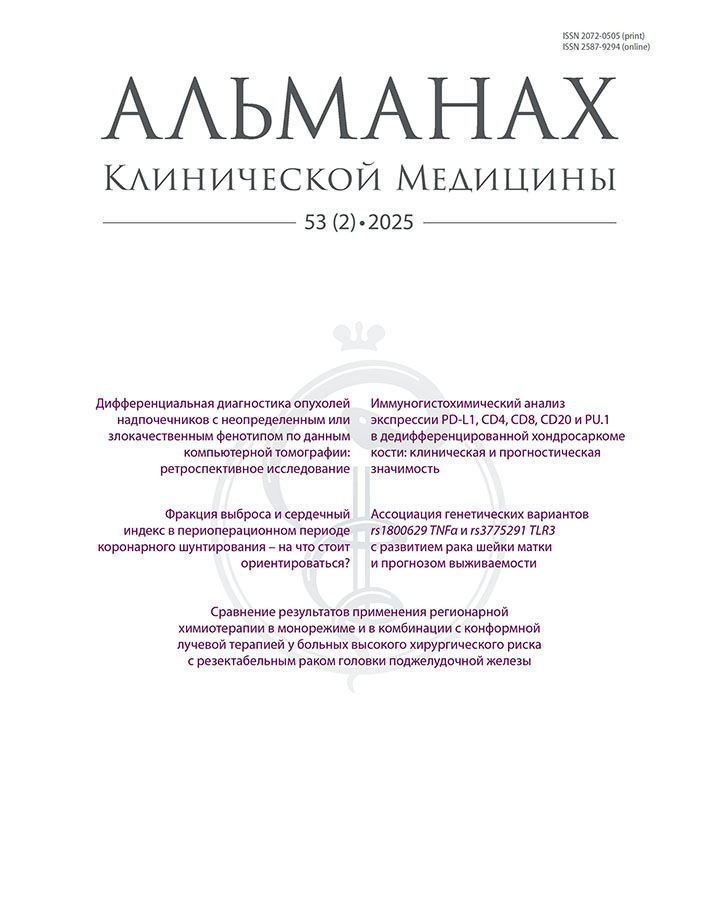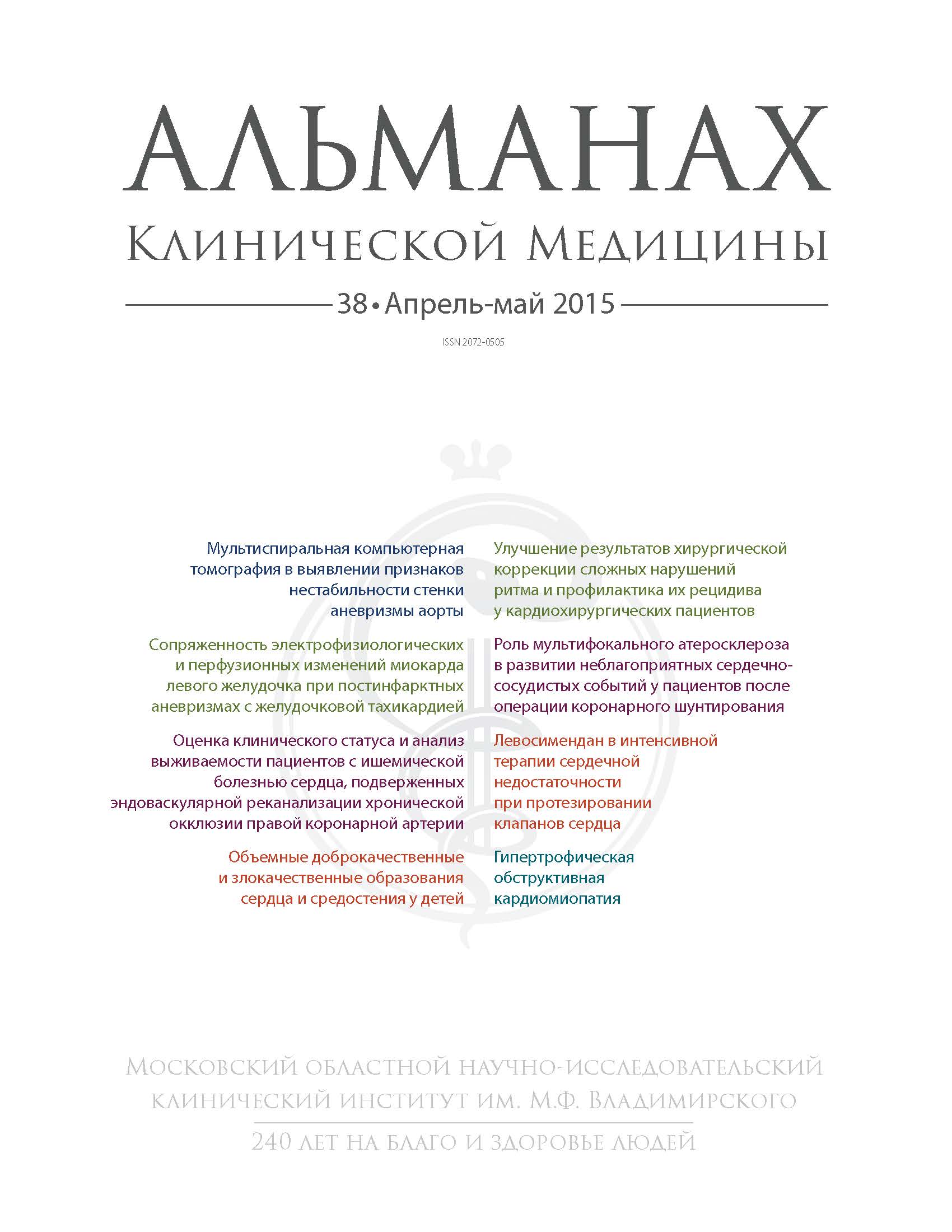ИММУНОЛОГИЧЕСКАЯ ФУНКЦИЯ ИНТЕСТИНАЛЬНОЙ МИКРОФЛОРЫ, ЕЕ НАРУШЕНИЯ И ВОЗМОЖНОСТИ КОРРЕКЦИИ
- Авторы: Урсова Н.И.1
-
Учреждения:
- Московский областной научно-исследовательский клинический институт имени М.Ф. Владимирского
- Выпуск: № 40 (2015)
- Страницы: 35-46
- Раздел: АКТУАЛЬНАЯ ПРОБЛЕМА
- URL: https://almclinmed.ru/jour/article/view/92
- DOI: https://doi.org/10.18786/2072-0505-2015-40-35-46
- ID: 92
Цитировать
Полный текст
Аннотация
В обзоре представлены современные данные, свидетельствующие о том, что нормальная микрофлора играет важную роль в развитии иммунной системы кишечника. Интестинальные микроорганизмы стимулируют созревание лимфоидного аппарата кишечника, синтез секреторного иммуноглобулина А, активизируют фагоцитоз, стимулируют систему цитокинов и интерферонов. Представляет интерес обсуждение информации о том, что феномен толерантности является наиболее значимым для создания устойчивого микробиоценоза. Для направленного формирования или восстановления нарушенного микробиоценоза все шире применяют пробиотики. В качестве одного из ключевых требований к пробиотикам признано подтверждение полезных свойств каждого штамма пробиотической культуры в контролируемых клинических исследованиях.
Об авторах
Н. И. Урсова
Московский областной научно-исследовательский клинический институт имени М.Ф. Владимирского
Автор, ответственный за переписку.
Email: ursovan@mail.ru
Урсова Наталия Игоревна – доктор медицинских наук, профессор, руководитель педиатрического отделения, заведующая кафедрой педиатрии факультета усовершенствования врачей, главный педиатр Министерства здравоохранения Московской области Россия
Список литературы
- Dethlefsen L, Eckburg PB, Bik EM, Relman DA. Assembly of the human intestinal microbiota. Trends Ecol Evol. 2006;21(9):517–23.
- Galdeano CM, de Moreno de LeBlanc A, Vinderola G, Bonet ME, Perdigón G. Proposed model: mechanisms of immunomodulation induced by probiotic bacteria. Clin Vaccine Immunol. 2007;14(5):485–92.
- Shida K, Nanno M. Probiotics and immunology: separating the wheat from the chaff. Trends Immunol. 2008;29(11):565–73. doi: 10.1016/j.it.2008.07.011.
- Magalhaes JG, Tattoli I, Girardin SE. The in testinal epithelial barrier: how to distinguish between the microbial flora and pathogens. Semin Immunol. 2007;19(2):106–15.
- Cummings JH, Antoine JM, Azpiroz F, Bourdet-Sicard R, Brandtzaeg P, Calder PC, Gibson GR, Guarner F, Isolauri E, Pannemans D, Shortt C, Tuijtelaars S, Watzl B. PASSCLAIM – gut health and immunity. Eur J Nutr. 2004;43 Suppl 2:II118–II173.
- Schenk M, Mueller C. The mucosal immune system at the gastrointestinal barrier. Best Pract Res Clin Gastroenterol. 2008;22(3):391– 409. doi: 10.1016/j.bpg.2007.11.002.
- Mowat AM. Anatomical basis of tolerance and immunity to intestinal antigens. Nat Rev Immunol. 2003;3(4):331–41.
- Kelly D, Conway S, Aminov R. Commensal gut bacteria: mechanisms of immune modulation. Trends Immunol. 2005;26(6):326–33.
- Mayer L, Shao L. Therapeutic potential of oral tolerance. Nat Rev Immunol. 2004;4(6):407–19.
- Hawrylowicz CM, O'Garra A. Potential role of interleukin-10-secreting regulatory T cells in allergy and asthma. Nat Rev Immunol. 2005;5(4):271–83.
- Man AL, Prieto-Garcia ME, Nicoletti C. Improving M cell mediated transport across mucosal barriers: do certain bacteria hold the keys? Immunology. 2004;113(1):15–22.
- Rescigno M, Borrow P. The host-pathogen interaction: new themes from dendritic cell biology. Cell. 2001;106(3):267–70.
- Brandtzaeg P. Development, regulation and function of secretory immunity. In: Delvin EE, Lentze MJ, editors. Gastrointestinal Functions. Philadelphia: Lippincott Williams & Wilkins; 2001. p. 91–114.
- Rescigno M, Urbano M, Valzasina B, Francolini M, Rotta G, Bonasio R, Granucci F, Kraehenbuhl JP, Ricciardi-Castagnoli P. Dendritic cells express tight junction proteins and penetrate gut epithelial monolayers to sample bacteria. Nat Immunol. 2001;2(4):361–7.
- Kelsall BL, Biron CA, Sharma O, Kaye PM. Dendritic cells at the host-pathogen interface. Nat Immunol. 2002;3(8):699–702.
- Smith PD, Smythies LE, Mosteller-Barnum M, Sibley DA, Russell MW, Merger M, Sellers MT, Orenstein JM, Shimada T, Graham MF, Kubagawa H. Intestinal macrophages lack CD14 and CD89 and consequently are down-regulated for LPSand IgA-mediated activities. J Immunol. 2001;167(5):2651–6.
- Sham HP, Yu EY, Gulen MF, Bhinder G, Stahl M, Chan JM, Brewster L, Morampudi V, Gibson DL, Hughes MR, McNagny KM, Li X, Vallance BA. SIGIRR, a negative regulator of TLR/IL-1R signalling promotes Microbiota dependent resistance to colonization by enteric bacterial pathogens. PLoS Pathog. 2013;9(8):e1003539. doi: 10.1371/journal.ppat.1003539.
- Hooper LV, Wong MH, Thelin A, Hansson L, Falk PG, Gordon JI. Molecular analysis of commensal host-microbial relationships in the intestine. Science. 2001;291(5505):881–4.
- Cassis L, Aiello S, Noris M. Natural versus adaptive regulatory T cells. Contrib Nephrol. 2005;146:121–31.
- Halabi-Tawil M, Ruemmele FM, Fraitag S, Rieux-Laucat F, Neven B, Brousse N, De Prost Y, Fischer A, Goulet O, Bodemer C. Cutaneous manifestations of immune dysregulation, polyendocrinopathy, enteropathy, X-linked (IPEX) syndrome. Br J Dermatol. 2009;160(3):645–51. doi: 10.1111/j.1365-2133.2008.08835.x.
- Bellinghausen I, Klostermann B, Knop J, Saloga J. Human CD4+CD25+ T cells derived from the majority of atopic donors are able to suppress TH1 and TH2 cytokine production. J Allergy Clin Immunol. 2003;111(4):862–8.
- Tanabe S, Kinuta Y, Saito Y. Bifidobacterium infantis suppresses proinflammatory interleukin-17 production in murine splenocytes and dextran sodium sulfate-induced intestinal inflammation. Int J Mol Med. 2008;22(2):181–5.
- O'Hara AM, O'Regan P, Fanning A, O'Mahony C, Macsharry J, Lyons A, Bienenstock J, O'Maho ny L, Shanahan F. Functional modulation of human intestinal epithelial cell responses by Bifidobacterium infantis and Lactobacillus salivarius. Immunology. 2006;118(2):202–15.
- Braun-Fahrländer C, Riedler J, Herz U, Eder W, Waser M, Grize L, Maisch S, Carr D, Gerlach F, Bufe A, Lauener RP, Schierl R, Renz H, Nowak D, von Mutius E; Allergy and Endotoxin Study Team. Environmental exposure to endotoxin and its relation to asthma in school-age children. N Engl J Med. 2002;347(12):869–77.
- Lauener RP, Birchler T, Adamski J, BraunFahrländer C, Bufe A, Herz U, von Mutius E, Nowak D, Riedler J, Waser M, Sennhauser FH; ALEX study group. Expression of CD14 and Toll-like receptor 2 in farmers' and non-farmers' children. Lancet. 2002;360(9331):465–6.
- Vidal K, Labéta MO, Schiffrin EJ, Donnet-Hughes A. Soluble CD14 in human breast milk and its role in innate immune responses. Acta Odontol Scand. 2001;59(5):330–4.
- Johansson SG, Hourihane JO, Bousquet J, Bruijnzeel-Koomen C, Dreborg S, Haahtela T, Kowalski ML, Mygind N, Ring J, van Cauwenberge P, van Hage-Hamsten M, Wüthrich B; EAACI (the European Academy of Allergology and Clinical Immunology) nomenclature task force. A revised nomenclature for allergy. An EAACI position statement from the EAACI nomenclature task force. Allergy. 2001;56(9): 813–24.
- Урсова НИ. Микробиоценоз открытых биологических систем организма в процессе адаптации к окружающей среде. Русский медицинский журнал. 2004;12(16):957–9.
- Conrad R, Phelps TJ, Zeikus JG. Gas metabolism evidence in support of the juxtaposition of hydrogen-producing and methanogenic bacteria in sewage sludge and lake sediments. Appl Environ Microbiol. 1985;50(3):595–601.
- Ogra PL, Faden H, Welliver RC. Vaccination strategies for mucosal immune responses. Clin Microbiol Rev. 2001;14(2):430–45.
- Uhlig HH, Mottet C, Powrie F. Homing of intestinal immune cells. Novartis Found Symp. 2004;263:179–88.
- van Ginkel FW, Nguyen HH, McGhee JR. Vaccines for mucosal immunity to combat emerging infectious diseases. Emerg Infect Dis. 2000;6(2):123–32.
- Campbell DJ, Kim CH, Butcher EC. Chemokines in the systemic organization of immunity. Immunol Rev. 2003;195:58–71.
- Penders J, Stobberingh EE, van den Brandt PA, Thijs C. The role of the intestinal microbiota in the development of atopic disorders. Allergy. 2007;62(11):1223–36.
- Shreiner A, Huffnagle GB, Noverr MC. The “Microflora Hypothesis” of allergic disease. Adv Exp Med Biol. 2008;635:113–34. doi: 10.1007/978-0-387-09550-9_10.
- Timmerman HM, Koning CJ, Mulder L, Rombouts FM, Beynen AC. Monostrain, multistrain and multispecies probiotics – a comparison of functionality and efficacy. Int J Food Microbiol. 2004;96(3):219–33.
- Beyer G, Hiemer-Bau M, Ziege S, Edlund C, Lode H, Nord CE. Impact of moxifloxacin versus clarithromycin on normal oropharyngeal microflora. Eur J Clin Microbiol Infect Dis. 2000;19(7):548–50.
- Mundy LM, Sahm DF, Gilmore M. Relationships between enterococcal virulence and antimicrobial resistance. Clin Microbiol Rev. 2000;13(4):513–22.
- Шендеров БА. Медицинская микробная экология и функциональное питание. Т. 3. Пробиотики и функциональное питание. М.: Грантъ; 2001. 286 с.
- Szajewska H, Mrukowicz JZ. Probiotics in the treatment and prevention of acute infectious diarrhea in infants and children: a systematic review of published randomized, double-blind, placebo-controlled trials. J Pediatr Gastroenterol Nutr. 2001;33 Suppl 2:S17–25.
- Bezkorovainy A. Probiotics: determinants of survival and growth in the gut. Am J Clin Nutr. 2001;73(2 Suppl):399S–405S.
- Бондаренко ВМ. Обоснование и тактика назначения в медицинской практике различных форм пробиотических препаратов. Фарматека. 2012;(13):89–99.
- Gorbach SL. Probiotics and gastrointestinal health. Am J Gastroenterol. 2000;95(1 Suppl):S2–4.
- Rolfe RD. The role of probiotic cultures in the control of gastrointestinal health. J Nutr. 2000;130(2S Suppl):396S–402S.
- Mercenier A, Pavan S, Pot B. Probiotics as biotherapeutic agents: present knowledge and future prospects. Curr Pharm Des. 2003;9(2):175–91.
- Joint FAO/WHO Working Group. Guidelines for the Evaluation of Probiotics in Food. London Ontario, Canada. April 30 and May 1, 2002. 11 p. Available from: http://www.who.int/foodsafety/ fs_management/en/probiotic_guidelines.pdf
- Chapman TM, Plosker GL, Figgitt DP. VSL#3 probiotic mixture: a review of its use in chronic inflammatory bowel diseases. Drugs. 2006;66(10):1371–87.
- Rachmilewitz D, Katakura K, Karmeli F, Hayashi T, Reinus C, Rudensky B, Akira S, Takeda K, Lee J, Takabayashi K, Raz E. Toll-like receptor 9 signaling mediates the anti-inflammatory effects of probiotics in murine experimental colitis. Gastroenterology. 2004;126(2):520–8.
- Bergonzelli GE, Blum S, Brussow H, CorthésyTheulaz I. Probiotics as a treatment strategy for gastrointestinal diseases? Digestion. 2005;72(1):57–68.
- Penner R, Fedorak RN, Madsen KL. Probiotics and nutraceuticals: non-medicinal treatments of gastrointestinal diseases. Curr Opin Pharmacol. 2005;5(6):596–603.
- Ghadimi D, Fölster-Holst R, de Vrese M, Winkler P, Heller KJ, Schrezenmeir J. Effects of probiotic bacteria and their genomic DNA on TH1/TH2-cytokine production by peripheral blood mononuclear cells (PBMCs) ofhealthy and allergic subjects. Immunobiology. 2008;213(8):677–92. doi: 10.1016/j.imbio.2008.02.001.
- Постникова ЕА, Пикина АП, Кафарская ЛИ, Ефимов БА. Изучение качественного и количественного состава микрофлоры кишечника у клинически здоровых детей в раннем возрасте. Журнал микробиологии. 2004;(1):62–7.
- Schell MA, Karmirantzou M, Snel B, Vilanova D, Berger B, Pessi G, Zwahlen MC, Desiere F, Bork P, Delley M, Pridmore RD, Arigoni F. The genome sequence of Bifidobacterium longum reflects its adaptation to the human gastrointestinal tract. Proc Natl Acad Sci U S A. 2002;99(22):14422–7.
- Tannock GW. Molecular assessment of intestinal microflora. Am J Clin Nutr. 2001;73(2 Suppl):410S–414S.
- Lu L, Walker WA. Pathologic and physiologic interactions of bacteria with the gastrointestinal epithelium. Am J Clin Nutr. 2001;73(6):1124S–1130S.
- Gill HS. Probiotics to enhance anti-infective defences in the gastrointestinal tract. Best Pract Res Clin Gastroenterol. 2003;17(5):755–73.
- Lebeer S, Vanderleyden J, De Keersmaecker SC. Genes and molecules of lactobacilli supporting probiotic action. Microbiol Mol Biol Rev. 2008;72(4):728–64. doi: 10.1128/MMBR.00017- 08.
- Perdigón G, Fuller R, Raya R. Lactic acid bacteria and their effect on the immune system. Curr Issues Intest Microbiol. 2001;2(1):27–42.
- Лиходед ВГ, Бондаренко ВМ. Антиэндотоксиновый иммунитет в регуляции численности микрофлоры кишечника. М.: Медицина; 2007. 216 с.
- Isolauri E, Kalliomäki M, Laitinen K, Salminen S. Modulation of the maturing gut barrier and microbiota: a novel target in allergic disease. Curr Pharm Des. 2008;14(14):1368–75.
- Isolauri E, Salminen S, Ouwehand AC. Microbial-gut interactions in health and disease. Probiotics. Best Pract Res Clin Gastroenterol. 2004;18(2):299–313.
- Isolauri E, Kirjavainen PV, Salminen S. Probiotics: a role in the treatment of intestinal infection and inflammation? Gut. 2002;50 Suppl 3:III54–9.
- Walker WA, Goulet O, Morelli L, Antoine JM. Progress in the science of probiotics: From cellular microbiology and applied immunology to clinical nutrition. Eur J Nutr. 2006;45(Suppl 9):1–18.
- Бондаренко ВМ. Молекулярно-клеточные механизмы терапевтического действия пробиотических препаратов. Фарматека. 2010;(2):26–32.
- Sanders ME. Considerations for use of probiotic bacteria to modulate human health. J Nutr. 2000;130(2S Suppl):384S–390S.
- Урсова НИ. Терапевтический потенциал современных пробиотиков. Педиатрическая фармакология. 2013;10(2):46–56.
Дополнительные файлы








